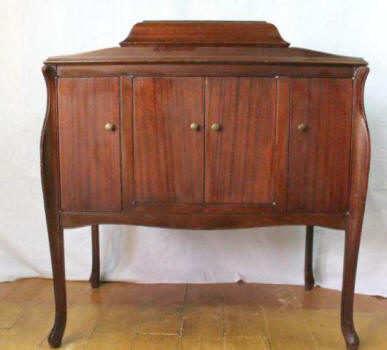
The Victor-Victrola Page

VV-260
RARITY: ¤ VALUE: ¤

 The
VV-260 was a mid-range 'console-style' phonograph, introduced in early
1922. Its debut was concurrent with the reorganizing of the entire Victrola
product line. These new models used conventional Arabic number designations
rather than the previous Roman numerals, but they were essentially cosmetic
variations of the same products that had been offered since 1906. The resounding success of console-style models which
were being produced by other phonograph manufacturers likely motivated Victor to
produce its own line of machines in the 'lowboy' horizontal style; however, the company did not want to mimic designs that others had
produced, so their first console machines had a 'hump-top' appearance. This
concept replicated the domed-lid profile that had been in use on their upright
phonograph models since 1907. The end-result was a rather strange looking
cabinet that was neither very practical (one could not place anything on top of
the machine since all surfaces were angled) nor particularly appealing.
The
VV-260 was a mid-range 'console-style' phonograph, introduced in early
1922. Its debut was concurrent with the reorganizing of the entire Victrola
product line. These new models used conventional Arabic number designations
rather than the previous Roman numerals, but they were essentially cosmetic
variations of the same products that had been offered since 1906. The resounding success of console-style models which
were being produced by other phonograph manufacturers likely motivated Victor to
produce its own line of machines in the 'lowboy' horizontal style; however, the company did not want to mimic designs that others had
produced, so their first console machines had a 'hump-top' appearance. This
concept replicated the domed-lid profile that had been in use on their upright
phonograph models since 1907. The end-result was a rather strange looking
cabinet that was neither very practical (one could not place anything on top of
the machine since all surfaces were angled) nor particularly appealing.
The expensive VV-300, introduced in June of 1921, was the
first Victrola with a hump-top cabinet. It initially sold quite well. The company
soon began making preparations to introduce lower-cost versions of this design,
but by the end of the year the hump-top machines were falling out of favor. The
public now preferred the practicality and appearance of flat-top console
phonographs, which were being offered by several competitors. By the time the
expanded line-up of hump-top Victrolas (including the mid-range VV-260) were launched
in early 1922, buyers
were already trending away from this style and sales were disappointing. Victor
then had to scramble to launch its own line of flat-top phonographs.
The VV-260 was a basic machine, with nickel-plated hardware, a two-spring
motor, and Victor's "No. 2" soundbox. They were
produced in a choice of mahogany, walnut or oak veneers. The original
1921 selling price of the VV-260 was $160.00, which equates to approximately $2,300.00 in
today's money. It had a slightly larger cabinet than the entry-level
VV-240 model; otherwise it was identical.
The initial design used had no carved trim on the cornerposts (left). Due
to slow sales, production was temporarily discontinued in the summer of 1923,
only to be re-started early the following year with a new, low-profile lid
design and a small section of hand-carved trim. The updated VV-260 failed to attract many new buyers,
and the model was permanently discontinued that summer.
A total of just over 56,000 VV-260 machines were produced. Compare that figure
to more than 100,000 VV-215 flat-top
models, selling for about the same price.
Victor ultimately produced more
of these models than could be sold at list price. Due to this
overproduction, it is quite likely that many late-production VV-260 machines were sold during Victor's well-advertised "half-price" sale
during the summer of 1925. For more information on Victor's financial crisis of
1924-1925 and the overproduction of phonographs, please click
here.
In general, collector interest in the VV-260 (and many similar console-style
Victrola models) is very weak today. The minimal ornamentation and 'mass
production' designs of these later-vintage Victrolas provide (in the view of
many) a far less appealing package than can be found in some of the elegant upright models.
The survival database currently shows the earliest existent VV-260 to be S/N 889 and the latest to be S/N 55850
|
|
Serial Number Range | Feature Notess |
| 1922 | 501-35000 | |
| 1923 | 32001-49300 | Production temporarily suspended mid-year |
| 1924 | 49301-56500 | Modernized cabinet |
Do you own a Victrola VV-260? Please take a moment and enter some basic information about your machine into the collector's database by clicking here. No personal information is required.